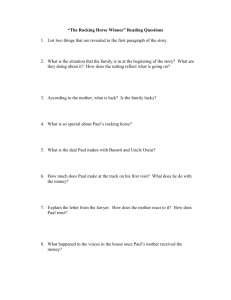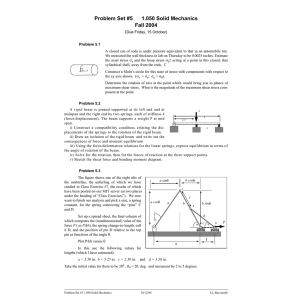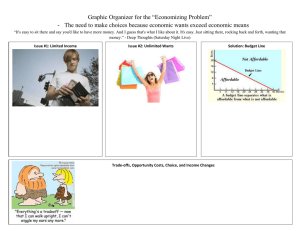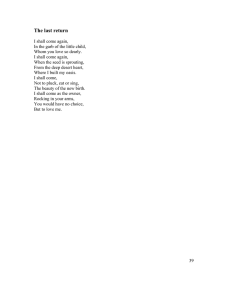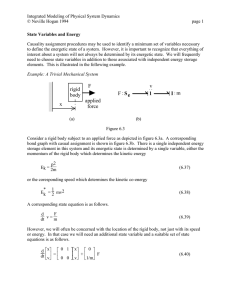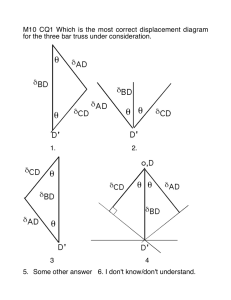RESPONSE ANALYSIS OF RIGID STRUCTURES ROCKING ON YIELDING FOUNDATION
advertisement
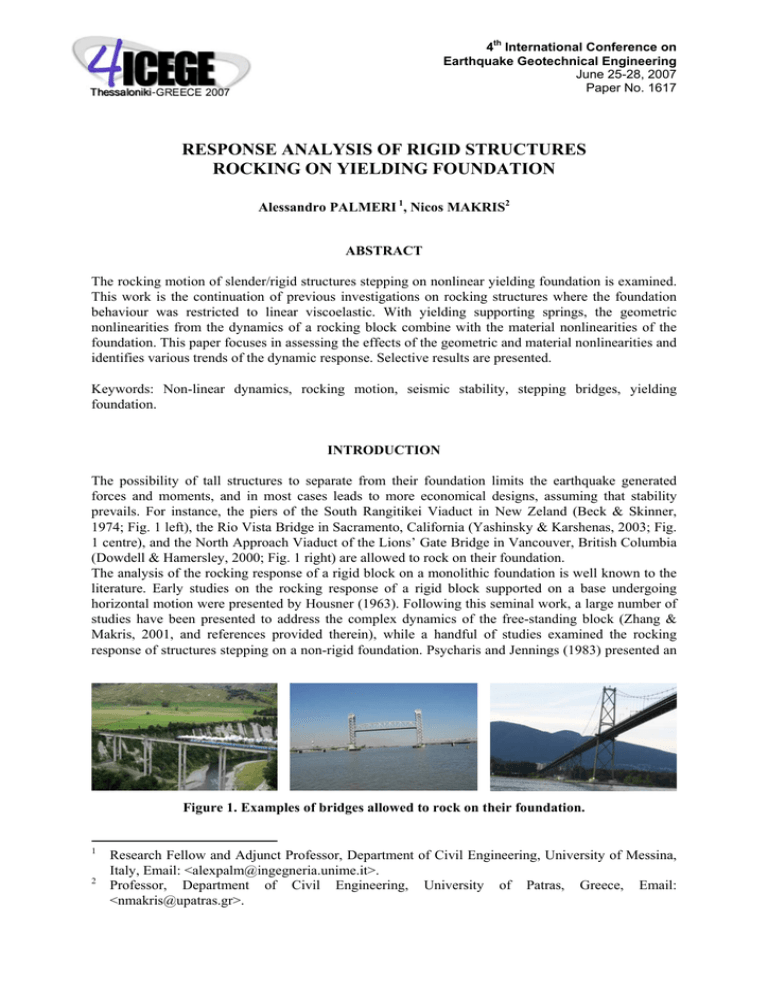
4th International Conference on
Earthquake Geotechnical Engineering
June 25-28, 2007
Paper No. 1617
RESPONSE ANALYSIS OF RIGID STRUCTURES
ROCKING ON YIELDING FOUNDATION
Alessandro PALMERI 1, Nicos MAKRIS2
ABSTRACT
The rocking motion of slender/rigid structures stepping on nonlinear yielding foundation is examined.
This work is the continuation of previous investigations on rocking structures where the foundation
behaviour was restricted to linear viscoelastic. With yielding supporting springs, the geometric
nonlinearities from the dynamics of a rocking block combine with the material nonlinearities of the
foundation. This paper focuses in assessing the effects of the geometric and material nonlinearities and
identifies various trends of the dynamic response. Selective results are presented.
Keywords: Non-linear dynamics, rocking motion, seismic stability, stepping bridges, yielding
foundation.
INTRODUCTION
The possibility of tall structures to separate from their foundation limits the earthquake generated
forces and moments, and in most cases leads to more economical designs, assuming that stability
prevails. For instance, the piers of the South Rangitikei Viaduct in New Zeland (Beck & Skinner,
1974; Fig. 1 left), the Rio Vista Bridge in Sacramento, California (Yashinsky & Karshenas, 2003; Fig.
1 centre), and the North Approach Viaduct of the Lions’ Gate Bridge in Vancouver, British Columbia
(Dowdell & Hamersley, 2000; Fig. 1 right) are allowed to rock on their foundation.
The analysis of the rocking response of a rigid block on a monolithic foundation is well known to the
literature. Early studies on the rocking response of a rigid block supported on a base undergoing
horizontal motion were presented by Housner (1963). Following this seminal work, a large number of
studies have been presented to address the complex dynamics of the free-standing block (Zhang &
Makris, 2001, and references provided therein), while a handful of studies examined the rocking
response of structures stepping on a non-rigid foundation. Psycharis and Jennings (1983) presented an
Figure 1. Examples of bridges allowed to rock on their foundation.
1
2
Research Fellow and Adjunct Professor, Department of Civil Engineering, University of Messina,
Italy, Email: <alexpalm@ingegneria.unime.it>.
Professor, Department of Civil Engineering, University of Patras, Greece, Email:
<nmakris@upatras.gr>.
equivalent linear analysis of the rocking response of a rigid block stepping on a viscoelastic
foundation, Yim and Chopra (1984) presented a linear analysis of a flexible structure supported on a
base allowed to uplift, while Gazetas (1999) documented the permanent tilting of buildings due to
foundation failure. More recently, Palmeri and Makris (2005) investigated in depth the rocking
response of a rigid block which steps on linear viscoelastic supports via a fully non-linear analysis,
which complements the linear one presented by Psycharis and Jennings (1983).
In this paper, we present a study on the rocking response of a rigid block which steps on yielding
supports. It is assumed that the foundation system cannot take tension; therefore, separation occurs
when the upward displacement of the heel of the structure is greater than the static deflection of the
support. The developed methodology is applied to the response analysis of a bridge peer that is
allowed to step, with the aim of investigating the effects that a non-rigid foundations has on the
rocking response of tall/slender structures.
STATEMENT OF THE PROBLEM
We consider in this study the rigid block of mass M shown in Fig. 2, in which R0 is the size and α
is the angle of slenderness. The nonlinear supports at the points L and R are yielding springs with
vertical stiffness K = ωv2 M 2 and yielding deflection δ y . The springs do not take tension, and the
rigid block can pivot about points L and R when it is set to rocking. In Fig. 2, the horizontal dotdashed line is used for the position where the supporting springs are unstressed.
When the motion is weak, then the body is in continuous contact with both supports at pivot points L
and R. When the vertical uplift of the heel of the body exceeds the static deflection of the supporting
springs, δs, then separation occurs: e.g., in the stage B of Fig. 2 the separation is imminent, i.e. the
supporting spring at the heel (point R) is unstressed, while in the stage C the body is supported only at
its toe (point L); the contact at the heel is successively re-established in the stage E, where the support
is waiting in the unstressed configuration (see stages C and D).
According to Fig. 2, the rigid block can experience three regimes of motion: (i) full-contact at both
points L and R (stages A, B, and E to G in Fig. 2); (ii) contact only at point L (stages C and D, in
which the block is tilting to the left); and (iii) contact only at point R (stage H and I, in which the
block is tilting to the right). There is a fourth regime of motion, when the rigid body separates from
both supports, which is not the subject of this study: when this happens, our analysis terminates.
It is worth noting that, given the elastoplastic behaviour of the supporting springs, Fig. 2 shows the
plastic deformations accumulated at the pivot points (e.g., the transition between stage C and D),
which may determine a permanent tilting of the block at the end of the motion. As an example, in the
stage E of Fig. 2 the elastic deformations at the pivot points L and R are the same, as in initial stage A;
however, in the stage E the rigid block shows a nonzero rotation due to the plastic deformation
cumulated at the pivot point L, while prior to the stage A the supporting springs have not experienced
plastic deformations.
The loss of energy caused by the impacts is governed in our analysis by the ratio of the velocity of the
imminent pivot point before the impact to the velocity of the pivot point after the impact at the
support. This ratio defines the coefficient of restitution, ε = vLa vLb = vRa vRb , which has been introduced
by Psycharis and Jennings (1983). Given the abovementioned parameters, the rotation θ of a rigid
block rocking on a two-support yielding foundation can be expressed by:
θ = f (α , µ , p, ε , ωv ,η ,excitation )
(1)
where µ = M R02 / I 0 is the shape factor of the rigid block, being I 0 the moment of inertia of the rigid
block with respect to the centre of mass; η = δ y δ s is the bearing capacity index of the foundation;
and p is a frequency parameter, which results from its size, R0 , and the intensity of the surrounding
gravitational field, g :
O
R0
α
δs
L
R
R
K,δy
A
L
B
C
R
L
D
E
F
G
H
I
Figure 2. Regimes of motion of a rigid block rocking on yielding foundation.
p=
µ
g
µ + 1 R0
(2)
Eq. (1) indicates that there are six parameters of the rocking structure-foundation system that influence
its response other the characteristics of the ground excitation.
For a bridge tower, the frequency parameter can be as low as p = 0.5rad/s or even smaller; whereas
for a household refrigerator p = 2.0 rad/s . The slenderness of a 10 m tall classical column can be as
low as α = 10° ≅ 0.17 rad ; whereas, the slenderness of a three-storey building which is 8 m wide is
approximately α = 36° ≅ 0.62 rad . The vertical frequency, ωv , can originate from the vertical stiffness
of an elastoplastic device or the stiffness of a conventional foundation, depending on the configuration
of the rocking structure. Accordingly, practical values of interest for the ratio β = ωv p are in the
range 10 < β < 100 . Of course, there may be special cases where the ratio β lies outside this range.
Finally, the values of the coefficient of restitution, ε , and the static safety factor η = δ y δ s are in the
range 0 ≤ ε ≤ 1 and η > 1 .
EQUATIONS OF MOTION
Since the rigid block is not allowed to slide, the system has only two degrees of freedom. Among the
severable possible choices, we select the vertical displacement of the centre of mass, v , and the
rotation of the block, θ (see Fig. 3). Using the two degrees of freedom, the equations of motion in the
full-contact regime can be derived in the form:
gη
⎧
⎪ v + 2 ( zL + zR ) = − g − vg (t )
⎪
1+ µ 2
⎪
2
p η {[sin(α ) + cos(α )θ ] zL − [sin(α ) − cos(α )θ ] zR } =
⎨ ⎡⎣1 + µ cos (α ) ⎤⎦ θ +
2
⎪
ug (t )
⎪
−(1 + µ ) p 2 cos(α )
⎪
g
⎩
(3)
where ug (t ) and vg (t ) are the time histories of the horizontal and of the vertical components of the
ground acceleration, respectively; while zL and zR are the dimensionless hysteretic variables
associated with the yielding springs at the pivot points L and R, respectively, which are proportional
with the corresponding reaction forces:
FL = Fy zL ; FR = Fy zR
(4)
in which Fy = K δ y is the yielding force of the supporting springs. When the rigid block separates
from the support on the right, the associated hysteretic variables goes to zero, zR = 0 , and the
equations of motion are:
gη
⎧
⎪⎪v + 2 zL = − g − vg (t )
⎨
u (t )
⎪ ⎡1 + µ cos 2 (α ) ⎤ θ + 1 + µ p 2 η [sin(α ) + cos(α )θ ] zL = −(1 + µ ) p 2 [ cos(α ) − sin(α )θ ] g
⎣
⎦
⎪⎩
g
2
(5)
In the same way, when the rigid block separates from the support on the left, zL = 0 , and the equations
of motion are:
v
O
α
θ
R0
R
L
vg (t )
K
ug (t )
δy
Figure 3. Schematic of a rigid block rocking on yielding foundation.
F
F
Fy
K
F,v
n
K
δy
K
δy
K
K
v
v
Figure 4. Rheological model (right) and hysteretic loop (centre) for the ideal elastic-perfectly
plastic behaviour. Hysteretic loop of the Bouc-Wen model.
gη
⎧
⎪⎪v + 2 zR = − g − vg (t )
⎨
u (t )
⎪ ⎡1 + µ cos 2 (α ) ⎤ θ + 1 + µ p 2 η [sin(α ) − cos(α )θ ] zR = −(1 + µ ) p 2 [ cos(α ) + sin(α )θ ] g
⎣
⎦
⎪⎩
g
2
(6)
Each of Eqs. (3), (5) and (6) rules the dynamic equilibrium of the rigid block in one of the three
regimes of motion depicted in Fig. 2. These equations, however, have to be coupled with those ruling
the time variation of the hysteretic variables zL and zR , whose values depends in principle on the
whole time histories of the vertical displacements of the pivot points L and R, respectively:
vL = v + R0 sin(α )θ ; vR = v − R0 sin(α )θ
(7)
Among the rheological models available in the literature for the hysteresis of yielding springs, the
simplest one is the elastic-perfectly plastic model (Fig. 4 left and centre), made of an elastic spring
with stiffness K in series with a Coulomb element with sliding force Fy = K δ y . The ideal elasticperfectly plastic model can be effectively approximated by the Bouc-Wen model (Bouc, 1967; Wen,
1976), which is described by the equations:
F (t ) = K δ y z (t )
z (t ) =
v ⎡
n −1
n
1 − 0.5sign(v) z z − 0.5 z ⎤
⎦
δy ⎣
(8)
where n is a dimensionless parameter that controls the rate of the transition between the elastic and
the perfect plastic phases (Fig. 4 right). In the following, it is always assumed n = 5 .
Taking into account Eqs. (7), the state equations ruling the hysteretic variables zL and zR when the
rigid block is in contact with the supporting springs can be derived in the form:
⎧
⎡
β 2 ⎡ p2
µ sin(α ) ⎤ ⎧⎪
µ g sin(α ) ⎤ n −1
n⎫
⎪
θ ⎥ ⎨1 − 0.5sign ⎢v +
θ ⎥ zL zL − 0.5 zL ⎬
⎪ zL =
⎢ v +
2
1+ µ
(1 + µ ) p ⎦
η ⎣g
⎣
⎦ ⎩⎪
⎪
⎭⎪
⎨
⎡
β 2 ⎡ p2
µ sin(α ) ⎤ ⎧⎪
µ g sin(α ) ⎤ n −1
n⎫
⎪
⎪
z
zR − 0.5 zR ⎬
=
⎪ R η ⎢ g v − 1 + µ θ ⎥ ⎨1 − 0.5sign ⎢ v − (1 + µ ) p 2 θ ⎥ zR
⎪⎭
⎣
⎦
⎣
⎦ ⎪⎩
⎩
(9)
When the block separates from the right spring, the corresponding hysteretic variables takes the
constant value zR = 0 , and then zR = 0 . In the same way, when the block separates from the left
spring zL = 0 and zL = 0 .
RESPONSE ANALYSIS TO TRIGONOMETRIC PULSES
The ability of distinct pulses to generate a structural response that resembles the earthquake induced
response has been examined in past studies (Makris & Chang, 2000; Makris & Roussos, 2000;
Mavroeidis & Papageorgiou, 2003, and references reported therein). Some of the proposed pulses are
physically realizable motions with zero final ground velocity and finite acceleration whereas some
other idealizations violate one or both of the above requirements. Physically realizable pulses can
adequately describe the impulsive character of near-fault ground motions, both qualitatively and
quantitatively. According to Makris and his coworkers, the minimum number of parameters that
describe the pulses is two, which are the acceleration amplitude ap (or velocity amplitude vp ) and the
duration Tp , while the more sophisticated model by Mavroeidis and Papageorgiou (2003) involves
four parameters.
Pulse-type excitations are of key importance in this study because they allow investigating the effects
of the governing parameters on the seismic response of the block-foundation system. Of particular
interest are the forward motions, which can be approximated with a one-sine acceleration pulse, and
the forward-and-back motions, which can be approximated with a one-cosine acceleration pulse
(Makris & Chang, 2000; Makris & Roussos, 2000, among others).
As an example, Fig. 5 plots the responses to a one-sine pulse of a rigid block with slenderness angle
α = 0.20 rad (≅ 11.5°) , shape factor µ = 3 (rectangular shape) and frequency parameter p = 1 rad/s
( R0 = 7.36 m ) rocking on a rigid foundation (solid lines) and a two-support yielding foundation
(dashed lines), with different values of the static safety factor η = 5.0 , 3.0 , 2.5 and 2.2 . The
coefficient of restitution is assumed to be ε = 0.10 , while the stiffness parameter takes the
intermediate value β = ωv / p = 50 . When the value of the static safety factor is higher ( η = 5.0 , first
column from the left in Fig. 5) the rocking motion on rigid and non-rigid foundations are in good
agreement, in terms of normalized rotation θ α (first graph from the top), angular velocity θ (α p )
(second graph) and total energy E M (third graph, with values in J kg ). A more accurate inspection
of these graphs, however, reveals that the flexibility of the foundation initially increases the amount of
the energy that the ground motion transmits to the block (i.e., the peak of the total energy at the
beginning of the motion is higher), while successively more energy is dissipated each time that the
angle of rotation reverses (i.e., the total energy decades more rapidly). Interestingly, in this case
( η = 5.0 ) the total energy decreases only because the impacts, while no energy is dissipated in the
yielding springs: their response, in fact, is purely elastic, and there are no hysteretic loops in the v − F
plane (first graphs from the bottom in Fig. 5).
When the bearing capacity index reduces (i.e. η = 3.0 , 2.5 and 2.2 ), the rocking response on yielding
springs becomes gradually different from that one on monolithic base. In particular, the peak rotation
at the beginning of the motion decreases, while successively the block tilts to the left ( θ < 0 ): in the
first cycle of oscillation, in fact, the one-sine pulse induces a plastic (unrecoverable) deformation in
the spring on the left which is larger than that one on the right. This is illustrated in the time history of
the normalized rotation θ α for the lower value of the bearing capacity index ( η = 2.2 , first column
from the right in Fig. 5). In this case, in fact, at the ending the block oscillates completely under the
shaded band which indicates the interval of rotation [−θ ,θ ] where rigid block and two-support
foundation are in full-contact under a weak rocking motion, being:
⎤
1+ µ
⎥
2
⎣ µ β sin(α ) ⎦
⎡
θ = arcsin ⎢
(10)
Moreover, Fig. 5 shows that the smaller is the bearing capacity index, the larger is the energy
dissipated in the oscillations of the rigid block. When the ratio η = δ y δ s reduces, in fact, the loss of
energy is given not only at the impacts, but also during the plastic deformations in the supporting
springs. This is confirmed by the hysteretic loops (first row from the bottom in Fig. 5), which encircle
a larger area as the static safety factor η decreases. Finally, in the case where η = 2.2 (first column
from the right in Fig. 5) one can see that the total energy E takes negative values; indeed, the plastic
η = 5.0
0
θ
α
θ
αp
E
M
2
4
η = 3.0
6
0
2
4
η = 2.5
6
0
2
4
η = 2.2
6
0
2
4
6
0.2
0.2
0.1
0.1
0
0
-0.1
-0.1
-0.2
-0.2
0.8
0.8
0.4
0.4
0
0
-0.4
-0.4
-0.8
-0.8
0.8
0.8
0.4
0.4
0
0
-0.4
-0.4
1
ug (t )
g
1
0.5
0.5
0
0
-0.5
-0.5
-1
-1
0
2
4
6
0
2
t [s]
4
6
0
2
t [s]
4
t [s]
6
0
2
4
6
t [s]
-6 -4 -2 0 -4 -2 0 -6 -4 -2 0 -4 -2 0 -6 -4 -2 0 -4 -2 0 -6 -4 -2 0 -4 -2 0
0
0
L
-0.25
F
Fy
R
-0.5
-0.5
-0.75
-1
-0.25
-0.75
L
R
L
R
L
R
-1
-6 -4 -2 0 -4 -2 0 -6 -4 -2 0 -4 -2 0 -6 -4 -2 0 -4 -2 0 -6 -4 -2 0 -4 -2 0
v δy
v δy
v δy
v δy
Figure 5. Normalized time histories of rotation θ , angular velocity θ and total energy E (top
graphs) of a rectangular block ( µ = 3 ) with parameters α = 0.20 rad and p = 1.0 rad/s
( R0 = 7.36 m ) rocking on a yielding foundation with parameters β = 50 , ε = 0.10 and various
values of the safety factor η , when subjected to a one-sine type-A pulse ( ap = 1.00 g , Tp = 0.5 s ).
Hysteretic loops v − F (bottom graphs) of the yielding springs.
deformations cumulated in the yielding springs determine a permanent settlement of the rigid block,
and then the potential energy becomes negative.
Fig. 6 plots the responses to a one-cosine pulse of a slender rigid block ( α = 0.15 rad ≅ 8.6° ). The
static safety factor is assumed to be η = 2.5 and the stiffness parameter takes the values
β = ωv / p = 20 , 40 , 60 and 100 , while the other parameters are the same as in the previous example.
In this case, interestingly, as stiff is the foundation (i.e., as large is β ), as large is the peak rotation of
the rigid block rocking on yielding springs. All these values, however, are less than the peak rotation
of the rigid block rocking on rigid base. In this circumstance, then, the use of rigid base allows to
estimate in a conservative way the peak rotation of the rocking structure. More sophisticated models,
however, are needed when the inelastic demand in the foundation is dealt with: the simple two-spring
model considered in this study, for instance, shows that as stiff is the foundation (i.e., as large is β ),
as large is the inelastic demand (see the hysteretic loops in the first row from the bottom in Fig. 6).
RESPONSE ANALYSIS TO EARTHQUAKE LOADING
Following the response analysis to trigonometric pulses our study proceeds with the response analysis
to earthquake loading after selecting six strong ground motions chronologically listed in Table 1. The
proposed nonlinear formulation is used to estimate the seismic-induced response of a stepping bridge
about 60 m tall. Frequency parameter, angle of slenderness and shape factor of the tower are assumed
to be p = 0.38 rad/s , α = 0.13 rad ( ≅ 7.4° ) and µ = 3 , respectively. Moreover, in our analyses the
coefficient of restitution takes the value ε = 0.05 , while four combinations of parameters β and η
are considered: 1) β = 40 and η = 2.5 ; 2) β = 40 and η = 3.5 (larger yielding deflection); 3) β = 80
(stiffer foundation) and η = 2.5 ; and 4) β = 80 and η = 3.5 . The peak rotations computed with these
combinations of the foundation parameters are also compared with that one computed with a
monolithic base.
Fig. 7 plots the peak normalized rotations of the tower of interest when subjected to the six ground
motions listed in Table 1, including also the vertical component. They are ordered with increasing
peak ground acceleration, from PGA = 0.515 g (1992 Erzikan) to 1.497 g (1992 Cape Mendocino).
One can see that for the first three ground motions a foundation with larger values of stiffness and/or
yielding deflection produces larger responses; in these cases, moreover, the model with rigid base
Table 1. Information pertinent to the strong motions selected in this study.
Earthquake
(Date)
Station
(Component∗)
M
D
km
PGD
m
PGV
m/s
PGA
g
Loma Prieta,
California
(18-Oct-1989)
16 LGCP
(000)
6.9
6.1
0.412
0.948
0.563
Erzikan, Turkey
(13-Mar-1992)
95 Erzikan
(NS)
6.9
2.0
0.273
0.839
0.515
7.1
8.5
0.410
1.274
1.497
6.7
6.4
0.327
0.130
0.843
6.7
7.1
0.288
1.661
0.838
6.9
0.3
0.358
0.127
0.611
Cape Mendocino,
89005 Cape
California
Mendocino
(25-Apr-1992)
(000)
Northridge,
24514 Sylmar Olive
California
View Med FF
(17-Jan-1994)
(360)
Northridge,
77 Rinaldi
California
Receiving Station
(17-Jan-1994)
(228)
Kobe, Japan
(16-Jan-1995)
∗ NS: North-South.
0 Takatori
(000)
β = 20
0
θ
α
θ
αp
E
M
ug (t )
g
2
4
β = 40
6
0
2
4
β = 60
6
0
2
β = 100
4
6
0
2
4
6
0.6
0.2
0.3
0.1
0
0
-0.3
-0.1
-0.6
-0.2
2
2
1
1
0
0
-1
-1
2.4
2.4
1.6
1.6
0.8
0.8
0
0
1
1
0.5
0.5
0
0
-0.5
-0.5
-1
-1
0
2
4
6
0
2
t [s]
4
6
0
2
t [s]
4
6
0
2
t [s]
4
6
t [s]
-6 -4 -2 0 -4 -2 0 -6 -4 -2 0 -4 -2 0 -6 -4 -2 0 -4 -2 0 -6 -4 -2 0 -12 -6 0
0
0
R
-0.25
F
Fy
L
R
-0.5
-0.5
-0.75
-1
-0.25
-0.75
L
R
L
R
L
-1
-6 -4 -2 0 -4 -2 0 -6 -4 -2 0 -4 -2 0 -6 -4 -2 0 -4 -2 0 -6 -4 -2 0 -12 -6 0
v δy
v δy
v δy
v δy
Figure 6. Normalized time histories of rotation θ , angular velocity θ and total energy E (top
graphs) of a rectangular block ( µ = 3 ) with parameters α = 0.15 rad and p = 1.0 rad/s
( R0 = 7.36 m ) rocking on a yielding foundation with parameters ε = 0.10 , η = 2.50 and various
values of β when subjected to a one-cosine type-B pulse ( ap = 1.00 g , Tp = 1.0 s ). Hysteretic
loops v − F (bottom graphs) of the yielding springs.
0.12
θ max
α
1995 Kobe
PGA= 0.611 g
0.12
0.08
0.08
0.04
0.04
0
0.12
θ max
α
1989 Loma Prieta
PGA= 0.563 g
1992 Erzican
PGA= 0.515 g
1
2
3
4
1994 Northridge, Rinaldi
PGA= 0.838 g
1
2
3
4
1994 Northridge, Sylmar
PGA= 0.843 g
1
2
3
4
1992 Cape Mendocino
PGA= 1.497 g
0
0.12
0.08
0.08
0.04
0.04
0
1
2
3
4
1
2
3
4
1
2
3
4
0
⎯ : Rigid foundation
Case No. 1 (+): β=40, η=2.5
Case No. 3 (’): β=80, η=2.5
Case No. 2 (,): β=40, η=3.5
Case No. 4 (*): β=80, η=3.5
Figure 7. Maximum rotation values of the bridge tower when subjected to the strong motions
listed in Table 1.
(solid lines) gives conservative estimations of the peak rotation. Remarkably, in two among the last
three ground motions the opposite happens. Nevertheless, what is important to note is that large
variations in the mechanical properties of the foundation have just a small effect on the value of the
peak rotation. Furthermore, the tower, although very slender ( α = 0.13 rad ), experiences always small
rotations because it has such large size ( p = 0.36 rad/s , and R0 = 60.1 m ). More precisely: i ) the
maximum peak rotation of the stepping bridge under analysis ( θ max = 0.114α ) is induced by the 1989
Loma Prieta earthquake ( PGA = 0.563 g ) when the base is assumed rigid; and ii ) , contrary to what
one would intuitively expect, the minimum peak rotation ( θ max = 0.0191α ) is induced by the 1992
Cape Mendocino earthquake, which exhibits the maximum peak ground acceleration
( PGA = 1.497 g ), and also in this case when the base is assumed rigid.
CONCLUSIONS
In this paper, the rocking response of slender/rigid structures stepping on nonlinear yielding
foundation is investigated. The response analysis of this study complements previous investigations
where the foundation behaviour is restricted to linear viscoelastic. A novel set of equations of motion
is presented, where two hysteretic variables are included, aimed to account for the plastic deformations
cumulated in the supports. In the proposed model the geometric nonlinearities arising from the
dynamics of a rocking block combine with the material nonlinearities of the foundation. As a result,
the response of the rocking block to a given accelerogram depends on its size, shape and slenderness,
together with the stiffness and the yielding deflection of the foundation, and with the amount of energy
dissipated during the impacts.
The numerical examples presented herein demonstrate that a simple model with rigid base may give
accurate estimations of the peak rotation, while more refined models are required when the inelastic
demand in the foundation is of importance. Some counterintuitive results are also emphasized: for
instance, an increase in the stiffness and/or in the strength of the foundation may indifferently produce
larger or smaller rotations.
ACKNOWLEDGEMENTS
We thank the European Social Fund (ESF), Operational Program for Educational and Vocational
Training II (EPEAEK II), and particularly the Program PYTHAGORAS II, for funding the above
work.
REFERENCES
Beck JL and Skinner RI. “The seismic response of a reinforced concrete bridge pier designed to step,”
Earthquake Engineering and Structural Dynamics, 2, 343-58, 1974.
Bouc R. “Forced vibration of mechanical systems with hysteresis,” Proc. 4th Conf. on Nonlinear
Oscillation, 1967.
Dowdell DJ and Hamersley BA. “Lions’ Gate Bridge North Approach – Seismic retrofit,” Proc. 3rd
International Conference STESSA 2000, 319-26, 2000.
Gazetas G. “Overturning and settlement in Adapazari during the 1999 Izmit (Turkey) Earthquake,”
Proc. 1st International Conf. on the Kocaeli Earthquake, 1999.
Housner GW. “The behaviour of inverted pendulum structures during earthquakes,” Bulletin of the
Seismological Society of America, 53, 404-17, 1963.
Makris N and Black CJ. “Dimensional analysis of rigid-plastic and elastoplastic structures under
pulse-type excitations,” Journal of Engineering Mechanics – ASCE, 130, 1006-18, 2004a.
Makris N and Black CJ. “Dimensional analysis of bilinear oscillators under pulse-type excitations,”
Journal of Engineering Mechanics – ASCE, 130, 1019-31, 2004b.
Makris N and Black CJ. “Evaluation of peak ground velocity on a ‘good’ intensity measure for nearsource ground motions,” Journal of Engineering Mechanics – ASCE, 130, 1032-44, 2004c.
Makris N and Chang SP. “Effect of viscous, viscoplastic and friction damping on the response of
seismic isolated structures,” Earthquake Engineering and Structural Dynamics, 29, 85-107, 2000.
Makris N and Roussos Y. “Rocking response of rigid blocks under near source ground motions,”
Geotechnique, 50, 243-62, 2000.
Mavroeidis GP Papageorgiou AS. “A mathematical representation of near-fault ground motions,”
Bulletin of the Seismological Society of America, 93, 1099-131, 2003.
Palmeri A and Makris N. “Response analysis of rigid structures rocking on viscoelastic foundation,”
Report No. EEAM 2005-02, Department of Civil Engineering, University of Patras, Greece, 2005.
Psycharis IN and Jennings PC. “Rocking of slender rigid bodies allowed to uplift,” Earthquake
Engineering and Structural Dynamics, 11, 57-76, 1983.
Wen YK, “Method for random vibration of hysteretic systems,” J. Engineering Mechanics Division –
ASCE, 102, 249-63, 1976.
Yashinsky M and Karshenas MJ. “Fundamental of seismic protection for bridges,” EERI Monograph
MNO-9, Earthquake Engineering Research Institute, Oakland, California, 2003.
Yim CK, Chopra AK and Penzien J. “Rocking response of rigid blocks to earthquakes,” Earthquake
Engineering and Structural Dynamics, 8, 565-87, 1980.
Zhang J and Makris N. “Rocking response and overturning of free-standing blocks under cycloidal
pulses,” Journal of Engineering Mechanics – ASCE, 127, 473-83, 2001.
